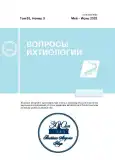Feeding Ecology of Red Seabream, Pagrus major (Sparidae) in the Korea Strait
- Авторлар: Jin S.1, Kim D.G.1, Seong G.C.1, Kang D.Y.1, Jeong J.M.2, Kim H.J.2, Baeck G.W.1
-
Мекемелер:
- Department of Marine Biology and Aquaculture Science, Department of Aquaculture Science, Institute of Marine Industry, Marine Bio-Education and Research Center, College of Marine Science, Gyeongsang National University, Tongyeong-si, Republic of Korea
- Fisheries Resources Research Center, National Institute of Fisheries Science, Tongyeong-si, Republic of Korea
- Шығарылым: Том 63, № 3 (2023)
- Беттер: 325
- Бөлім: Articles
- URL: https://journals.rcsi.science/0042-8752/article/view/135193
- DOI: https://doi.org/10.31857/S0042875223030062
- EDN: https://elibrary.ru/BYCQCF
- ID: 135193
Дәйексөз келтіру
Толық мәтін
Аннотация
The feeding ecology of red seabream, Pagrus major was studied using 1046 specimens collected by danish seine and bottom trawl from January to December 2018 in the Korea Strait. The size of the individuals ranged from 18.4 to 70.4 cm in fork length. Red seabream was a carnivore that consumed mainly anthozoans, brachyurans, and cephalopods. Its diets included also small quantities of amphipods, anomurans, ophiurids, gastropods, polychaetas, etc. We calculated the trophic level as 3.57 for red seabream. As red seabream grows, the proportion of relatively small prey items such as anomurans and ophiuroids decreases, while that of large prey items such as anthozoans, brachyurans, and cephalopods increases. In the largest size class (≥45 cm FL), cephalopods and pisces are its main prey. Alsoe, the body size of red seabream increased the mean weight of prey per stomach tended to increase significantly (One-way ANOVA: p < 0.05). The diet composition of red seabream showed seasonal changes. The cephalopods were the dominant prey items for all seasons. The weight proportion of brachyurans was higher in summer and autumn, whereas anthozoans feeding rate was the highest in winter. PERMANOVA analysis showed significant variations among size classes and seasons. The feeding intensity by size class and season observed no significant difference (One-way ANOVA: p > 0.05). As a result of the feeding strategy analysis, red seabream was a generalized feeder, with a wide niche width.
Негізгі сөздер
Авторлар туралы
S. Jin
Department of Marine Biology and Aquaculture Science, Department of Aquaculture Science, Institute of Marine Industry, Marine Bio-Education and Research Center, College of Marine Science, Gyeongsang National University, Tongyeong-si, Republic of Korea
Email: gwbaeck@gnu.ac.kr
Республика Корея, Чинджу
D. Kim
Department of Marine Biology and Aquaculture Science, Department of Aquaculture Science, Institute of Marine Industry, Marine Bio-Education and Research Center, College of Marine Science, Gyeongsang National University, Tongyeong-si, Republic of Korea
Email: gwbaeck@gnu.ac.kr
Республика Корея, Чинджу
G. Seong
Department of Marine Biology and Aquaculture Science, Department of Aquaculture Science, Institute of Marine Industry, Marine Bio-Education and Research Center, College of Marine Science, Gyeongsang National University, Tongyeong-si, Republic of Korea
Email: gwbaeck@gnu.ac.kr
Республика Корея, Чинджу
D. Kang
Department of Marine Biology and Aquaculture Science, Department of Aquaculture Science, Institute of Marine Industry, Marine Bio-Education and Research Center, College of Marine Science, Gyeongsang National University, Tongyeong-si, Republic of Korea
Email: gwbaeck@gnu.ac.kr
Республика Корея, Чинджу
J. Jeong
Fisheries Resources Research Center, National Institute of Fisheries Science, Tongyeong-si, Republic of Korea
Email: gwbaeck@gnu.ac.kr
Республика Корея, Пусан
H. Kim
Fisheries Resources Research Center, National Institute of Fisheries Science, Tongyeong-si, Republic of Korea
Email: gwbaeck@gnu.ac.kr
Республика Корея, Пусан
G. Baeck
Department of Marine Biology and Aquaculture Science, Department of Aquaculture Science, Institute of Marine Industry, Marine Bio-Education and Research Center, College of Marine Science, Gyeongsang National University, Tongyeong-si, Republic of Korea
Хат алмасуға жауапты Автор.
Email: gwbaeck@gnu.ac.kr
Республика Корея, Чинджу
Әдебиет тізімі
Қосымша файлдар









